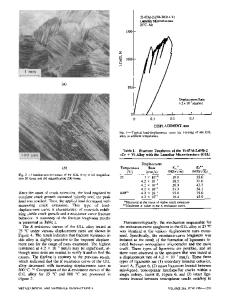Fundamental aspects of fatigue and fracture in a TiAl sheet alloy
- PDF / 1,373,509 Bytes
- 15 Pages / 612 x 792 pts (letter) Page_size
- 14 Downloads / 279 Views
I.
INTRODUCTION
THE fatigue and fracture characteristics of TiAl-based alloys have been studied extensively in recent years. This is in anticipation of the potential use of TiAl alloys for aerospace applications[1,14,43,44] that demand certain reliability and damage tolerance requirements be met. Additional interest in the TiAl alloys has also been generated by the possible use of these alloys for automotive applications.[15] The product form considered for these applications has been cast material, even though substantial improvement in properties has been made in the forged[1] and extruded[39–42] materials containing controlled microstructures. Processing of TiAl alloy sheet has been difficult because of its limited ductility. Recent advances, however, have allowed rolling of TiAl alloy sheet to produce a fine-grained (;10 mm) equiaxed g 1 a2 microstructure that is amenable to superplastic forming.[45,46,47] Additionally, the microstructure of the TiAl alloys can be manipulated by heat treatment to produce a fine-grained (,300 mm) lamellar microstructure. These advances enable one to examine the possible use of TiAl alloy sheet in aerospace applications that require high specific stiffness and damage tolerance characteristics. The effects of microstructure on strength and ductility,[1,2,22,23,39–42,48] fracture toughness,[22–42] large crack fatigue crack growth resistance,[1–14,17–19] and creep resistance of cast and forged TiAl alloys[2,40,49,50] are well established. One of the least understood areas of TiAl alloys is the fatigue crack nucleation process[32] and the growth of small cracks[13,20,21] into large, fatal cracks. Small cracks are defined as having [1–21]
[22–42]
K.S. CHAN, Institute Scientist, is with the Southwest Research Institute, San Antonio, TX 78238-5166. D.S. SHIH, Principal Technical Specialist, is with McDonnell Douglas Corporation, St. Louis, MO 63166-0516. This article is based on a presentation made in the symposium ‘‘Fundamentals of Gamma Titanium Aluminides,’’ presented at the TMS Annual Meeting, February 10–12, 1997, Orlando, Florida, under the auspices of the ASM/MSD Flow & Fracture and Phase Transformations Committees. METALLURGICAL AND MATERIALS TRANSACTIONS A
sizes less than or on the order of the relevant microstructural unit size, which is usually the grain size. Large cracks refer to cracks whose plastic zone size is sufficiently small to meet the criterion for small-scale yielding, but is large compared to the microstructural unit size. There have been a few studies on the growth of small cracks[13,20,21] and on the low-cycle fatigue and high-cycle fatigue (HCF) behavior of TiAl alloys in the cast or forged forms.[2,8,9,15,16] Chan and Davidson[32] reported that fatigue cracks nucleated first at slip bands in a forged large-grained lamellar TiAl alloy. Cyclic hardening, however, eventually arrests these slip band cracks. The fatal crack was subsequently initiated at forging defects of severely deformed lamellae that had the appearance of knots in wood. In a subsequent stu
Data Loading...











